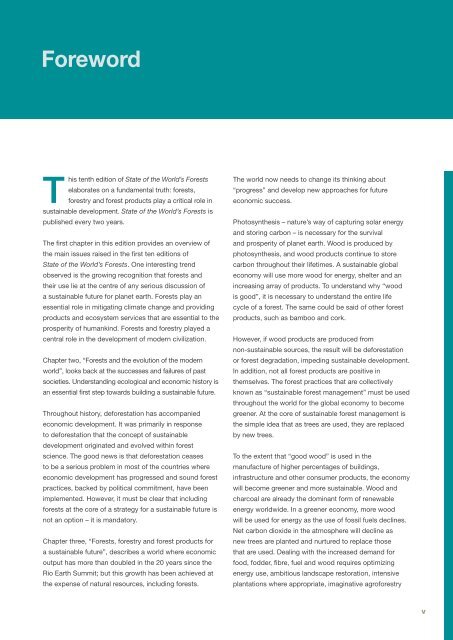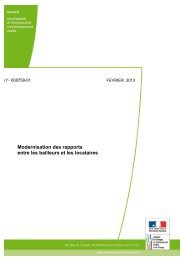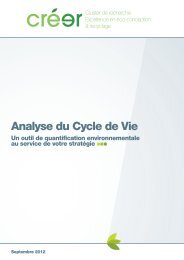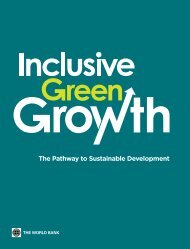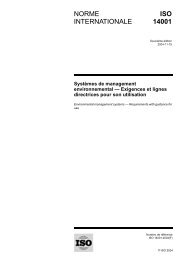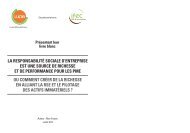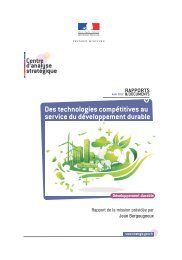State of the World's Forests 2012.pdf - D'Dline 2020
State of the World's Forests 2012.pdf - D'Dline 2020
State of the World's Forests 2012.pdf - D'Dline 2020
You also want an ePaper? Increase the reach of your titles
YUMPU automatically turns print PDFs into web optimized ePapers that Google loves.
ForewordThis tenth edition <strong>of</strong> <strong>State</strong> <strong>of</strong> <strong>the</strong> World’s <strong>Forests</strong>elaborates on a fundamental truth: forests,forestry and forest products play a critical role insustainable development. <strong>State</strong> <strong>of</strong> <strong>the</strong> World’s <strong>Forests</strong> ispublished every two years.The first chapter in this edition provides an overview <strong>of</strong><strong>the</strong> main issues raised in <strong>the</strong> first ten editions <strong>of</strong><strong>State</strong> <strong>of</strong> <strong>the</strong> World’s <strong>Forests</strong>. One interesting trendobserved is <strong>the</strong> growing recognition that forests and<strong>the</strong>ir use lie at <strong>the</strong> centre <strong>of</strong> any serious discussion <strong>of</strong>a sustainable future for planet earth. <strong>Forests</strong> play anessential role in mitigating climate change and providingproducts and ecosystem services that are essential to <strong>the</strong>prosperity <strong>of</strong> humankind. <strong>Forests</strong> and forestry played acentral role in <strong>the</strong> development <strong>of</strong> modern civilization.Chapter two, “<strong>Forests</strong> and <strong>the</strong> evolution <strong>of</strong> <strong>the</strong> modernworld”, looks back at <strong>the</strong> successes and failures <strong>of</strong> pastsocieties. Understanding ecological and economic history isan essential first step towards building a sustainable future.Throughout history, deforestation has accompaniedeconomic development. It was primarily in responseto deforestation that <strong>the</strong> concept <strong>of</strong> sustainabledevelopment originated and evolved within forestscience. The good news is that deforestation ceasesto be a serious problem in most <strong>of</strong> <strong>the</strong> countries whereeconomic development has progressed and sound forestpractices, backed by political commitment, have beenimplemented. However, it must be clear that includingforests at <strong>the</strong> core <strong>of</strong> a strategy for a sustainable future isnot an option – it is mandatory.Chapter three, “<strong>Forests</strong>, forestry and forest products fora sustainable future”, describes a world where economicoutput has more than doubled in <strong>the</strong> 20 years since <strong>the</strong>Rio Earth Summit; but this growth has been achieved at<strong>the</strong> expense <strong>of</strong> natural resources, including forests.The world now needs to change its thinking about“progress” and develop new approaches for futureeconomic success.Photosyn<strong>the</strong>sis – nature’s way <strong>of</strong> capturing solar energyand storing carbon – is necessary for <strong>the</strong> survivaland prosperity <strong>of</strong> planet earth. Wood is produced byphotosyn<strong>the</strong>sis, and wood products continue to storecarbon throughout <strong>the</strong>ir lifetimes. A sustainable globaleconomy will use more wood for energy, shelter and anincreasing array <strong>of</strong> products. To understand why “woodis good”, it is necessary to understand <strong>the</strong> entire lifecycle <strong>of</strong> a forest. The same could be said <strong>of</strong> o<strong>the</strong>r forestproducts, such as bamboo and cork.However, if wood products are produced fromnon-sustainable sources, <strong>the</strong> result will be deforestationor forest degradation, impeding sustainable development.In addition, not all forest products are positive in<strong>the</strong>mselves. The forest practices that are collectivelyknown as “sustainable forest management” must be usedthroughout <strong>the</strong> world for <strong>the</strong> global economy to becomegreener. At <strong>the</strong> core <strong>of</strong> sustainable forest management is<strong>the</strong> simple idea that as trees are used, <strong>the</strong>y are replacedby new trees.To <strong>the</strong> extent that “good wood” is used in <strong>the</strong>manufacture <strong>of</strong> higher percentages <strong>of</strong> buildings,infrastructure and o<strong>the</strong>r consumer products, <strong>the</strong> economywill become greener and more sustainable. Wood andcharcoal are already <strong>the</strong> dominant form <strong>of</strong> renewableenergy worldwide. In a greener economy, more woodwill be used for energy as <strong>the</strong> use <strong>of</strong> fossil fuels declines.Net carbon dioxide in <strong>the</strong> atmosphere will decline asnew trees are planted and nurtured to replace thosethat are used. Dealing with <strong>the</strong> increased demand forfood, fodder, fibre, fuel and wood requires optimizingenergy use, ambitious landscape restoration, intensiveplantations where appropriate, imaginative agr<strong>of</strong>orestryv


